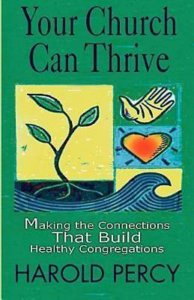Sharing faith stories nurtures an awareness of how God is working among us. Harold Percy outlines two simple approaches to sharing faith stories that can encourage people to consider and share how faith has shaped their lives.
Churches seeking to develop a witnessing and inviting membership should make a point of encouraging their members to tell their faith stories to one another and of providing plenty of opportunities for them to do so. They should seek to make this a normal and expected part of congregational life. In worship services, at committee meetings, at social events, in all sorts of meetings and courses, devise ways for people to spend some time hearing one another’s stories.
As these stories are shared in various settings, an amazing thing happens. People become aware, in a deep way, that God is among them and that God is working in the lives of people they know. There is a reverence that develops as they become aware that they are standing on holy ground. This realization (which often comes as a surprise) that God is in fact among them and has been working in their lives and in the lives of people they know is a tremendous encouragement to the whole church. I don’t know of anything that has the potential for boosting congregational morale and enthusiasm as quickly and as powerfully as this simple act of storytelling.
It is also worth noting that the experience of telling these stories with others in the church provides the opportunity to practice in a friendly setting before setting out to tell them outside to people who might still be somewhat skeptical.
One approach to telling your faith story
Many people, in thinking of how they might outline their faith story, in order to be able to share it clearly and simply, find it helpful to think in terms of three main focal points that can function in a way as the three chapters of their story.
1. My life before turning to Christ. This chapter includes some reflection on the type of person I was when I was living outside of a vital faith and did not think of myself as a committed follower of Jesus. In this part of the story, I will want to say something about what my life was like, what I was living for, what I valued, what my worldview was like, how it was formed, and so on. I might even want to say something about my understanding of and feelings about Christianity, the church, and even religion in general.
2. How I met Christ. This chapter focuses on the various circumstances and influences in my life that eventually led me to become a follower of Jesus. What were the issues that led me to consider him? What were the questions I had? Who were the people who played influential roles in this process as I came to place my trust in Jesus and step out to follow him? What did this process look like and feel like?
3. My life with Christ. In this chapter we attempt to describe something of the difference it has made in my life to become an intentional follower of Jesus. How am I different from the person described in chapter one? How has it changed me as a spouse, as a parent, as a worker, as a friend, as a citizen? How have my goals and values changed? What difference has it made in my behavior? What are some of the challenges I face? What is my growing edge in this?
Another approach to telling a faith story
It is important to point out here that the previous outline does not fit the experience of many deeply committed and growing Christians. These are the people whose experience of the Christian faith is such that they cannot recall a time when they did not know themselves to be connected with Jesus and open to his presence in their lives. Such people are blessed indeed! In their case the three chapters read differently, perhaps something like this:
1. Early Christian influences in my life. Rather than reflecting on life apart from Christ, this chapter usually tells of what it was like to grow up in a Christian home with parents (or a parent) who were committed to Christ and who taught their children from earliest childhood about the God who loves them and what Jesus has done for them. It might include the experience of being part of a church that took children seriously and helped them to worship and grow in their faith. It might include reflections on the comfort of Christ’s presence in various situations and the security of being assured of God’s love. What a wonderful thing it is to be able to include a chapter like this in your faith story. Many people who come to faith in later life dearly wish that they could tell this chapter instead.
2. Making it my own. For those who tell this version of the story, there is usually a period in adolescence or early adulthood when they have to go through the process of owning the faith for themselves. They become aware that they cannot go on forever on the faith of their parents and their church community; they are now responsible for the direction of their own life, and there are important choices to make. This sometimes (but not always) includes some serious wrestling with issues and choices as they consider what their life will be about.
3. My life with Christ today. As in the first version, this chapter focuses on what it means for me today to be a follower of Jesus and how my faith influences the way I think and live.
 Excerpted from Your Church Can Thrive: Making the Connections that Build Healthy Congregations (Abingdon Press, 2003) by Harold Percy. Available at Cokesbury and Amazon.
Excerpted from Your Church Can Thrive: Making the Connections that Build Healthy Congregations (Abingdon Press, 2003) by Harold Percy. Available at Cokesbury and Amazon.
Related Resources
- 5 Essential Qualities of Effective Evangelism by Priscilla Pope-Levison
- Friendship as a Means of Discipleship by Greg Moore
- Missional Engagement: It’s All About Relationships by Junius B. Dotson






